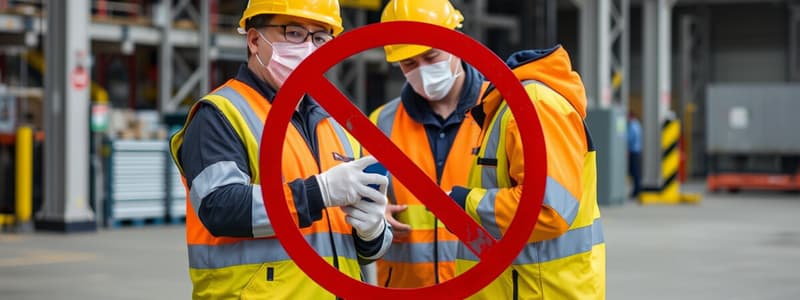Podcast
Questions and Answers
What was a primary cause of the damage to the bunker hose during offshore operations?
What was a primary cause of the damage to the bunker hose during offshore operations?
- Both vessels were moving in different directions. (correct)
- The hose was tied off to the supply vessel's anchor.
- The crane was overloaded with equipment.
- The crew forgot to inspect the hose beforehand.
What was the immediate consequence of the damage to the bunker hose?
What was the immediate consequence of the damage to the bunker hose?
- Bunkering operations continued as planned.
- The supply vessel capsized.
- A spill to the environment occurred.
- Bunkering was cancelled. (correct)
What action was taken to manage the risks associated with tying off the bunker hose?
What action was taken to manage the risks associated with tying off the bunker hose?
- All operations were suspended indefinitely.
- New equipment was purchased for the crane.
- The crew was retrained on crane operations.
- Bridge communication orders were updated. (correct)
During which part of the operation did the bunker hose get damaged?
During which part of the operation did the bunker hose get damaged?
What type of environmental risk was identified due to the damaged bunker hose?
What type of environmental risk was identified due to the damaged bunker hose?
What was the nature of the injury sustained by the crew person during the incident?
What was the nature of the injury sustained by the crew person during the incident?
What was identified as the root cause of the incident?
What was identified as the root cause of the incident?
Which safety controls were followed by the crew during the confined space entry?
Which safety controls were followed by the crew during the confined space entry?
What action did the injured crew person take during the fall?
What action did the injured crew person take during the fall?
Which of the following was a factor that contributed to the environment inside the tank?
Which of the following was a factor that contributed to the environment inside the tank?
Flashcards are hidden until you start studying
Study Notes
Safety Flash Highlights
- IMCA Safety Flashes are designed to share critical safety information and incidents, promoting learning across the community.
- Emphasis on anonymizing data to ensure confidentiality while sharing crucial safety alerts.
Loss of Pressure to Diver's Air Supply
- A diver experienced a pressure drop in their high-pressure supply regulator; recovered safely.
- Inspections revealed dried lubricant causing friction affecting the regulator’s performance.
- Light breathing from the diver led to insufficient pressure for proper regulation.
- Diving supervisor managed the situation effectively, ensuring diver safety without activating the secondary supply.
Equipment Related Injury
- An incident occurred where equipment fell on a worker's leg during a movement task.
- Incident highlights the risk in storage areas, particularly while cleaning equipment rooms.
Emergency Musters and Drills
- Incident 1: A stuck emergency alarm button delayed activation during a drill, raising concerns about equipment reliability.
- Recommendation to regularly test emergency alarm systems to ensure functionality.
- Incident 2: A smoldering fire from improper disposal of a cigarette butt could escalate due to negligence.
- Importance of adhering to fire safety protocols in designated areas.
Bunker Hose Damage during Connection
- Damage to a bunker hose occurred during offshore operations due to stretching from vessel movements.
- Hose was tied off to the supply vessel while still connected to the crane, complicating the operational dynamics.
- Resulting actions included a review of risk assessments and bridge communication protocols regarding hose handling during bunkering.
- Highlighted the critical need for procedure adherence to prevent environmental spills and operational delays.
Overview of Incidents
- Loss of azimuth control affected thruster operations on a Floating Production Unit (FPU).
- Divers were safely recovered due to prompt communication and supervision by the Diving Supervisor.
- The turret rotation was locked, mitigating risks during the incident.
What Went Right
- The dive was aborted successfully.
- Divers returned to the surface safely through a controlled operation.
What Went Wrong
- Routine maintenance should not occur during diving operations with only one thruster in service.
- Lack of risk assessment in heading control and Emergency Preparedness Plan contributed to incident severity.
- Communication from FPU control regarding diver status was unclear.
- Greasing of the main steering pump was not typically allowed during diving operations.
- No Lock-out/Tag-out (LOTO) procedures for standby unit led to unexpected failures.
Incident Contribution Factors
- A 26 cubic metre tank, larger than planned, was unfamiliar to operators with no prior documentation.
- Tank design required manual air inlet valve operation to prevent vacuum—this step was omitted, leading to implosion.
- Inadequate supplier onboarding and familiarization regarding new equipment specifications.
- Insufficient insight into new suppliers' experiences during risk assessments.
Specific Equipment and Procedures
- MEG (Monoethylene glycol) is used to prevent hydrate formation in subsea pipelines.
- Third-party operators lacked knowledge of the carbon fibre tank specifications.
Subsequent Actions
- Emphasis on enhanced onboarding for new suppliers and better familiarization with equipment.
- Operators to be trained on equipment specs and risk assessment documentation.
- Management of Change (MoC) processes to be reinforced when changing equipment, particularly with third-party gear.
United States Coastguard Alert (USCG)
- Safety Alert 02-24 issued about hazards from discarded munitions, which include active explosives and chemical agents.
- Significant amounts of munitions remain buried post-1970 dumping practices posing risks to ocean floor workers.
Clamming Vessel Incident
- A deckhand was burned by an unexploded canister while dredging clams, highlighting risks with discarded munitions.
Chain Hoist Incident
- An electric chain hoist failed, causing a 30kg container to fall onto a crew member, resulting in bruising and contusion.
Tank Slip Incident
- A crew member slipped exiting a freshwater tank due to pooling water during cleaning operations, resulting in a closed fracture of the forearm.
- Safety controls and training were in place, but a slippery surface was the primary cause of the incident.
Studying That Suits You
Use AI to generate personalized quizzes and flashcards to suit your learning preferences.




